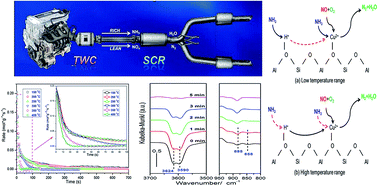The role and activity of various adsorbed ammonia species on Cu/SAPO-34 catalyst during passive-SCR process†
Abstract
In this work, the adsorption and reaction performance of various adsorbed ammonia species during the passive-SCR process were investigated by temperature-programmed desorption (TPD), temperature-fixed surface reaction (TFSR), in situ diffuse reflectance infrared Fourier transform spectroscopy (in situ DRIFTS) and kinetic tests. The NH3-TPD and DRIFTS-NH3 adsorption results showed that the number of weak and strong acid sites in the Cu/SAPO-34 sample increased due to Cu species incorporation, which formed new Lewis acid sites. Further, a decrease in the number of moderate acid sites resulted from the replacement of hydroxyls by Cu2+. The TFSR results revealed that the adsorbed NH3 species presented different SCR activity, which could be divided into active NH3 species and inactive NH3 species. In the low temperature range, a large amount inactive NH3 resulted in lower activity and resulted in a long equilibrium process. However, the performance of inactive NH3 was distinctly different at high temperatures. Furthermore, the in situ DRIFTS results illustrated the activity difference and migration between the two adsorbed NH3 species. It was proved that the NH3 migration rate from the Brønsted acid sites to Lewis acid sites was slower than the SCR rate at low temperatures, which might determine the SCR reaction rates. However, at high temperatures, the NH3 migration rate was faster than the SCR rate of active NH3. In other words, NH3 migration from the Brønsted acid sites to Lewis acid sites may be the rate determining step of passive-SCR lean period at low temperatures, while NH3 adsorption possibly was the rate determining step of the passive-SCR rich period at high temperatures. On the basis of the above results, the present work gives an insight into the potential of Cu/SAPO-34 for passive-SCR applications in the future.


 Please wait while we load your content...
Please wait while we load your content...